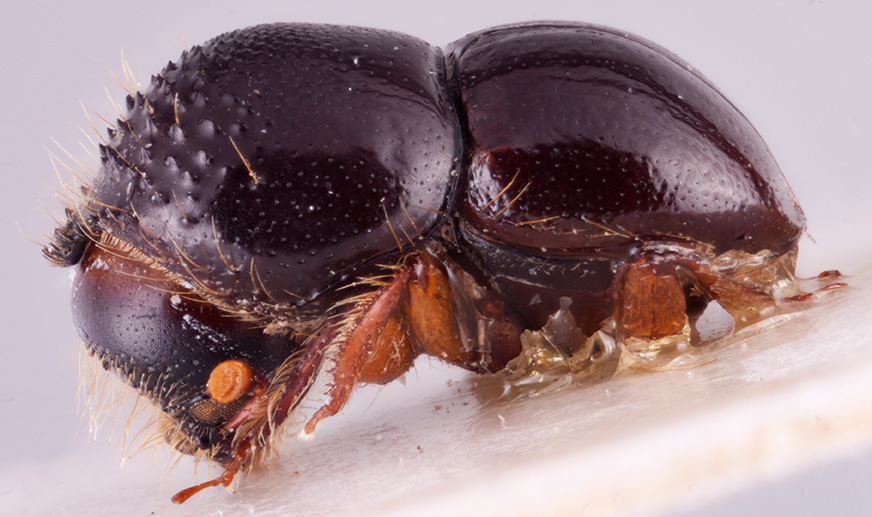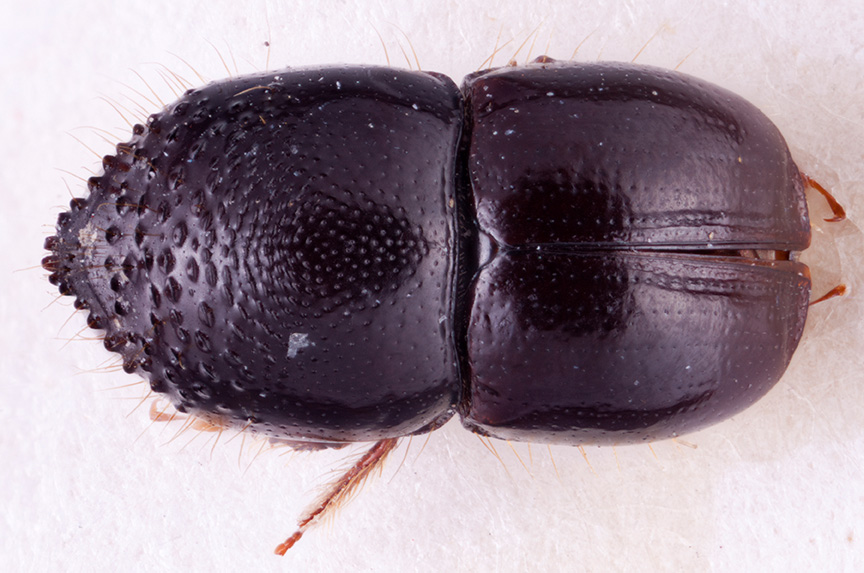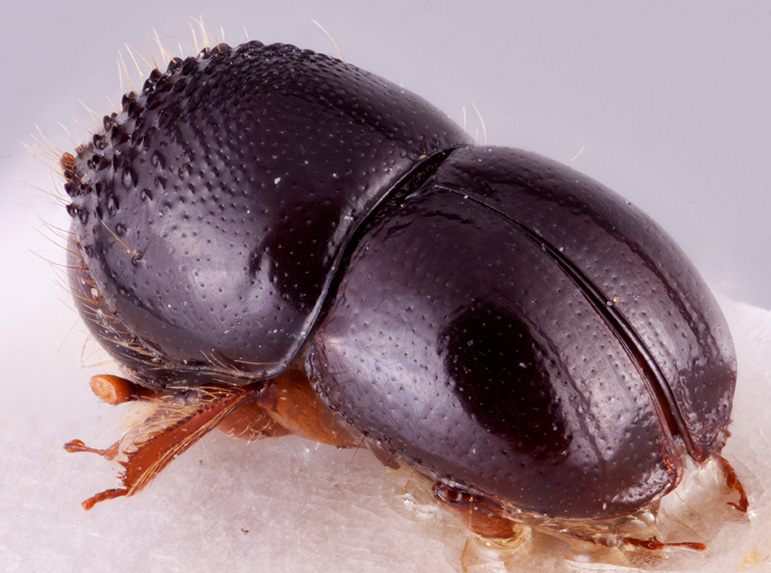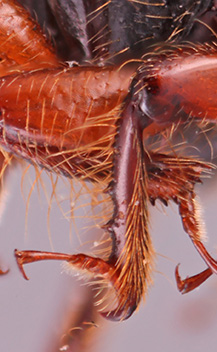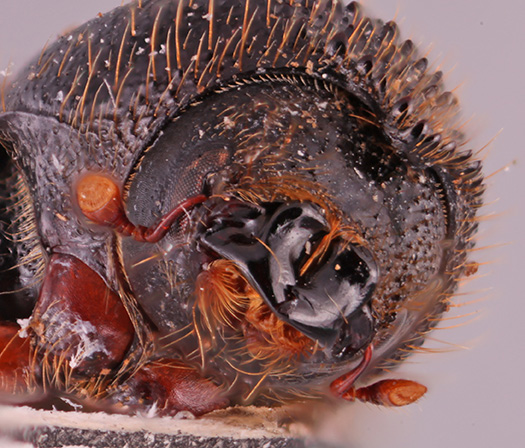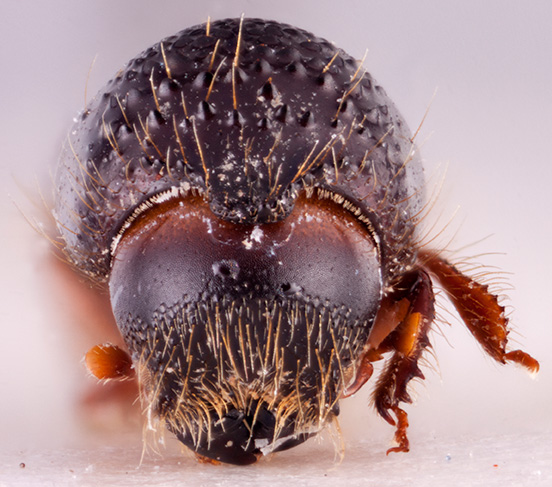Cnestus protensus
|
Cnestus protensus lateral; R.K. Osborn |
|
Cnestus protensus dorsal; R.K. Osborn |
|
Cnestus protensus declivity; R.K. Osborn |
|
Cnestus protensus protibia; S.M. Smith |
|
Cnestus protensus mandibles; S.M. Smith |
|
Cnestus protensus frontal; R.K. Osborn |
Taxonomic history
Xyleborus protensus Eggers, 1930: 201.
Cnestus protensus (Eggers): Wood and Bright, 1992: 803.
Synonyms
Cnestus rostratus Schedl, 1977: 502. Smith et al. 2020b: 151.
Diagnosis
3.3−5.4 mm long (mean = 4.35 mm; n = 4); 2.0− 2.17 times as long as wide. This species can be distinguished by the uniquely emarginateemarginate:
notched at the margin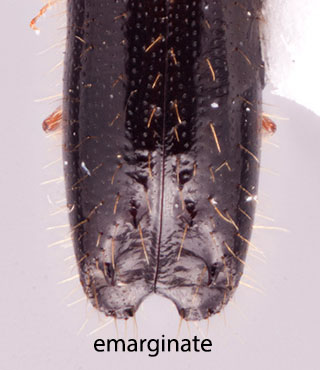 epistomal margin; enlarged mandibles (in laterallateral:
epistomal margin; enlarged mandibles (in laterallateral:
pertaining to the side
 view protruding forward at 90° to the plane of the fronsfrons:
view protruding forward at 90° to the plane of the fronsfrons:
region of the head from just above the epistoma to a point that is just dorsal to the inner apices of the eyes
, dorsoventrally deeper than normal; in anterioranterior:
the front or forward; opposite of posterior view, with an upwardly directed, smooth, rounded process on the dorsaldorsal:
view, with an upwardly directed, smooth, rounded process on the dorsaldorsal:
of or relating to the upper surface; opposite of ventral
 side); absence of a mesonotal mycangial tuftmycangial tuft:
side); absence of a mesonotal mycangial tuftmycangial tuft:
tuft of setae that denotes the mycangia exterior opening
 on the pronotalpronotal:
on the pronotalpronotal:
pertaining to the pronotum
basebase:
point or edge closest to the body; opposite of apex ; pronotumpronotum:
; pronotumpronotum:
the dorsal surface of the thorax
from dorsaldorsal:
of or relating to the upper surface; opposite of ventral
 view type 6; pronotumpronotum:
view type 6; pronotumpronotum:
the dorsal surface of the thorax
apexapex:
point or edge furthest from the body; opposite of base
 strongly producedproduced:
strongly producedproduced:
referring to a part of the exoskeleton that is extended, lengthened or elevated
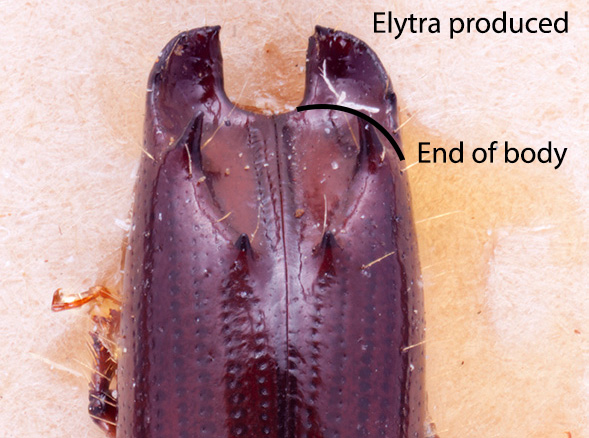 , extending to a process with numerous serrations; body glabrousglabrous:
, extending to a process with numerous serrations; body glabrousglabrous:
smooth, devoid of vestiture
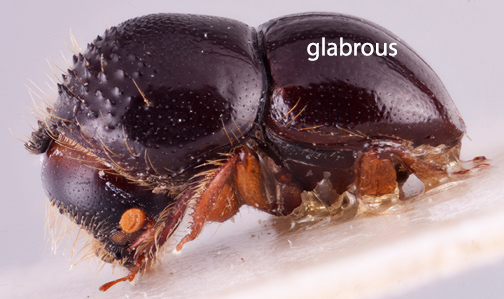 , strongly shiningshining:
, strongly shiningshining:
appearing glossy or bright in luster; referring to a surface that is polished and reflects light well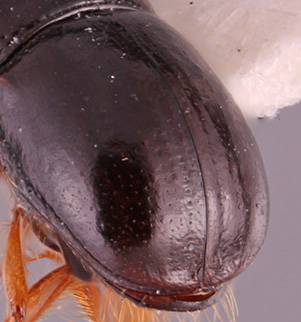 ; elytralelytral:
; elytralelytral:
pertaining to the elytra
declivitydeclivity:
downward slope of either the pronotum or elytra
 strongly rounded; protibiaprotibia:
strongly rounded; protibiaprotibia:
tibia of the first pair of legs
very slender with three large, narrow denticlesdenticle:
a small tooth, the sides of which are equal and the tip is above the middle of the base on outer margin; antennalantennal:
on outer margin; antennalantennal:
pertaining to the antennae
club type 1, with no sutures visible on the posteriorposterior:
toward the rear end; opposite of anterior
 face; and three segmented antennalantennal:
face; and three segmented antennalantennal:
pertaining to the antennae
funicle.
This species is very similar to C. nitidipennis and can be distinguished by the larger size, pronotalpronotal:
pertaining to the pronotum
basebase:
point or edge closest to the body; opposite of apex with punctures clearly coarser, denser, surface mostly dull, pronotumpronotum:
with punctures clearly coarser, denser, surface mostly dull, pronotumpronotum:
the dorsal surface of the thorax
appearing wider, sides of pronotumpronotum:
the dorsal surface of the thorax
parallel for approximately half of the total length.
May be confused with
Distribution
China (Yunnan), India (Assam), Indonesia (Java), Laos, Thailand, Vietnam
Host plants
recorded from Machilus (Lauraceae) (Smith et al. 2020bSmith et al. 2020b:
Smith SM, Beaver RA, and Cognato AI. 2020b. A monograph of the Xyleborini (Coleoptera, Curculionidae, Scolytinae) of the Indochinese Peninsula (except Malaysia) and China. ZooKeys 983: 1-442. https://doi.org/10.3897/zookeys.983.52630)
Remarks
Both C. nitidipennis and C. protensus possess unique morphology among Cnestus species, including the pronotalpronotal:
pertaining to the pronotum
apexapex:
point or edge furthest from the body; opposite of base
 very strongly producedproduced:
very strongly producedproduced:
referring to a part of the exoskeleton that is extended, lengthened or elevated
 , very slender protibiaprotibia:
, very slender protibiaprotibia:
tibia of the first pair of legs
, enlarged mandibles and absence of a mycangial tuftmycangial tuft:
tuft of setae that denotes the mycangia exterior opening
 . These morphological characters are convergent with Neotropical genera that are domicile parasites of other ambrosia beetles such as Sampsonius Eggers, 1935 (Xyleborini) and Amphicranus Erichson, 1836 (Corthylini) (Wood 2007Wood 2007:
. These morphological characters are convergent with Neotropical genera that are domicile parasites of other ambrosia beetles such as Sampsonius Eggers, 1935 (Xyleborini) and Amphicranus Erichson, 1836 (Corthylini) (Wood 2007Wood 2007:
Wood SL. 2007. Bark and ambrosia beetles of South America (Coleoptera: Scolytidae). Brigham Young University, M.L. Bean Life Science Museum; Provo, 900 p.). Further investigation of their behavior in is necessary to determine if these species are also domicile parasites.
DNA data
specimens not available for sequencing

